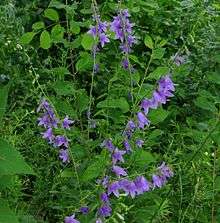Campanula rapunculoides
| Campanula rapunculoides | |
|---|---|
 | |
| Campanula rapunculoides, Ottawa, Ontario | |
| Scientific classification | |
| Kingdom: | Plantae |
| (unranked): | Angiosperms |
| (unranked): | Eudicots |
| (unranked): | Asterids |
| Order: | Asterales |
| Family: | Campanulaceae |
| Genus: | Campanula |
| Species: | C. rapunculoides |
| Binomial name | |
| Campanula rapunculoides L.[1] | |
| Synonyms[1] | |
Campanula rapunculoides, known by the common names creeping bellflower, or rampion bellflower, is a perennial herbaceous plant of the genus Campanula, belonging to the family Campanulaceae.
Etymology
The genus Latin name (“campanula”), meaning small bell, refers to the bell-shape of the flower, while the specific name (“rapunculoides”) refers to the similarity to Campanula rapunculus.
Description
Campanula rapunculoides reaches on average 30–80 centimetres (12–31 in) of height, with a maximum of 120 centimetres (47 in). The stem is simple, erect and lightly pubescent and the leaves are usually shortly hairy. The basal leaves are triangular, narrow, with a heart-shaped or rounded base, jagged edges and are up to 12 centimetres (4.7 in) long. The upper stem leaves are sessile, lanceolate and shortly stalked.
The inflorescence consists of nodding spikelike racemes with numerous drooping flowers. The flowers are bright blue-violet (rarely white), 2 to 4 cm long, with short petioles standing to one side in the axils of the bracts. The bracts are quite different and smaller than the leaves. The sepals are lanceolate to ovate-lanceolate, entire, wide at the base up to 2.5 mm. The corolla is bell-shaped, with five deep lobes slightly ciliate. The flowering period extends from June through September. The flowers are pollinated by insects (bees, flies, butterflies, etc.) (entomophily). The fruit is a capsule with five pores near the base, where the seeds are spread.
This plant has its overwintering buds situated just below the soil surface (hemicryptophyte). It spreads by underground rhizomes and produces deep, taproot-shaped tubers. Both are white and fleshy. Because any piece of the roots can sprout into a new plant, it is extremely hard to eradicate.
Distribution
This plant is native to Europe and western Siberia and it has been introduced to North America, where it has become an extremely invasive weed. It chokes out other plants, and eliminating it is nearly impossible due to its multiple propagation mechanisms.
Habitat
It grows on grassy places, dry hills, meadows, in deciduous and pine forests, woods, fields and roadsides, along railway lines and hedgerows, preferably in partial shade, in dry to moist sites and on clay soils, relatively rich in nitrogen, at an altitude of 0–2,000 metres (0–6,562 ft) above sea level. It also occurs in cultivated fields as a weed.
Gallery
 Illustration of Campanula rapunculoides (right) from Deutschlands Flora in Abbildunge (1796)
Illustration of Campanula rapunculoides (right) from Deutschlands Flora in Abbildunge (1796)- Plant of Campanula rapunculoides
- Close.up on flowers of Campanula rapunculoides
- Flowers of Campanula rapunculoides
- Leaf of Campanula rapunculoides
Invasive species in Alberta
Campanula rapunculoides (also known in Calgary as Creeping Bellflower, Rover Bellflower, Garden Bluebell, Creeping Bluebell, Purple Bell, Garden Harebell, Creeping Campanula and even the evil twin) is listed under invasive plants to avoid in Calgary, Alberta by the City of Calgary Parks Department.[2] According to the Minnesota Wild flowers website Campanula rapunculoides is a popular European import to North America. Each plant can produce 15, 000 seeds and it also reproduces through its long tuberous root system.[3]
References
- 1 2 Campanula rapunculoides was first described and published in Species Plantarum 165 1753. "TPL, treatment of Campanula rapunculoides L.". The Plant List; Version 1. (published on the internet). Royal Botanic Gardens, Kew and Missouri Botanical Garden. 2010. Retrieved March 14, 2013.
- ↑ "Garden centres free of invasive plants", City of Calgary Parks Department, Calgary, Alberta, nd, retrieved 5 August 2015
- ↑ "Campanula rapunculoides (Creeping Bellflower)", Minnesota Environment and Natural Resources Trust Fund, Minnesota Wild flowers, Minnesota, nd, retrieved 5 August 2015
- Pignatti S. - Flora d'Italia – Edagricole – 1982, Vol. II, pag. 695
External links
| Wikispecies has information related to: Campanula rapunculoides |
| Wikimedia Commons has media related to Campanula rapunculoides. |
- Biolib
- Plants.usda
- Wildflowers of Ontario
- Ontario Weeds: Creeping bellflower, Ontario Ministry of Agriculture
- Missouri Plants
- Kew Plant List
- IPNI Listing